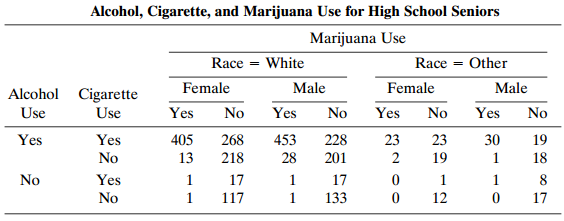Refer to Problem 11.2. Further study shows evidence of an interaction between gender and substance type. Using
Question:
logit(π̂) = €“ 0.57 + 1.93S1 + 0.86S2 + 0.38R €“ 0.20G + 0.37G × S1 + 0.22G × S2,
where R, G, S1, S2 are dummy variables for race (1 = white), gender (1 = female), and substance type (S1 = 1, S2 = 0 for alcohol; S1 = 0, S2 = 1 for cigarettes; S1 = S2 = 0 for marijuana). Show that:
a. The estimated odds a nonwhite male has used marijuana are exp( €“ 0.57) = 0.57.
b. Given gender, the estimated odds a white subject used a given substance are 1.46 times the estimated odds for a black subject.
c. Given race, the estimated odds a female has used alcohol are 1.19 times the estimated odds for males; for cigarettes and for marijuana, the estimated odds ratios are 1.02 and 0.82.
d. Given race, the estimated odds a female has used alcohol (cigarettes) are 9.97 (2.94) times the estimated odds she has used marijuana.
e. Given race, the estimated odds a male has used alcohol (cigarettes) are 6.89 (2.36) times the estimated odds he has used marijuana. Interpret the interaction.
Data from Prob. 11.2:
Refer to Table 9.1. Fit a marginal model to describe main effects of race, gender, and substance type (marijuana, alcohol, cigarettes) on whether a subject had used that substance. Summarize effects.
Table 9.1:

Step by Step Answer:






